Table of Contents
Angkor Wat: A Rich History of Cambodia
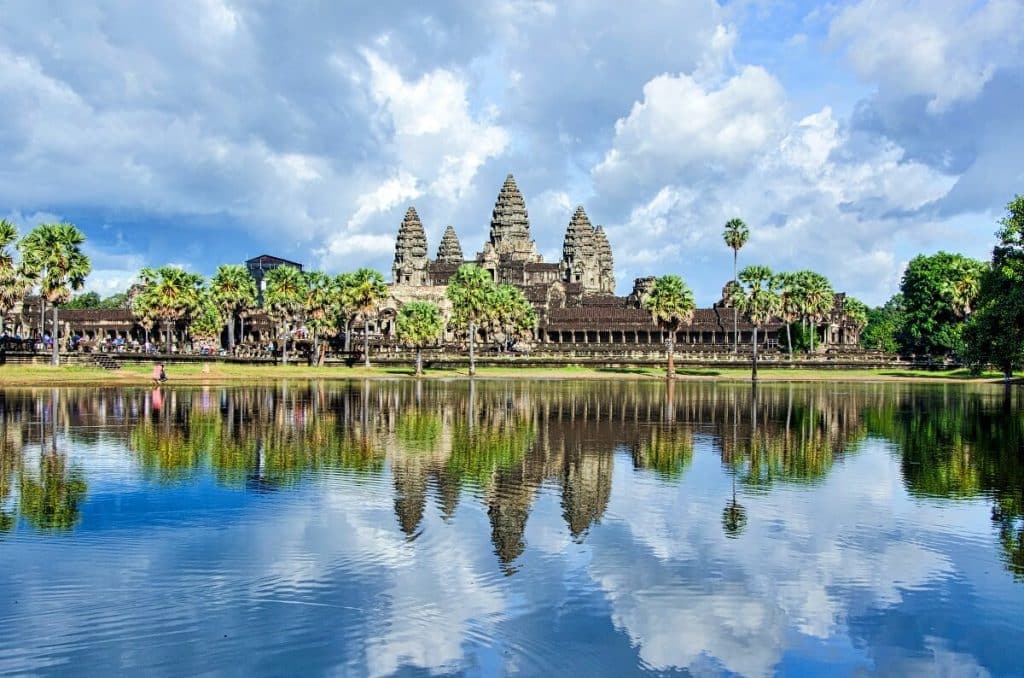
Although Cambodia is a part of my heritage, it is not the reason that ignited my interest in Angkor Wat. First, and foremost, I am very fond of history. Visiting historical sites around the world has always been the main reason for my travels. I love the thought of being able to walk through a time machine —step into another life, another world, another existence. So fascinating. To actually take a step that leads you back to 802 CE.
For other travellers of Cambodia, their fascination is more obvious, it the undeniably iconic Angkor Wat, built by the Khmer Empire. This ancient archaeological park is now one of the most visited UNESCO World Heritage Sites in the world, attracting more than 2 million fascinated visitors each year. Angkor houses many large and smaller temples, each as unique and historically packed as the next.
To fully understand Angkor, without feeling disconnected and lost while you’re standing there staring at ‘stone’, albeit beautifully, and intricately carved stone, understand a bit about Angkor’s background. The Kingdom, the Khmer people, their religion, and how it’s all connected.
When was Angkor Wat Built?
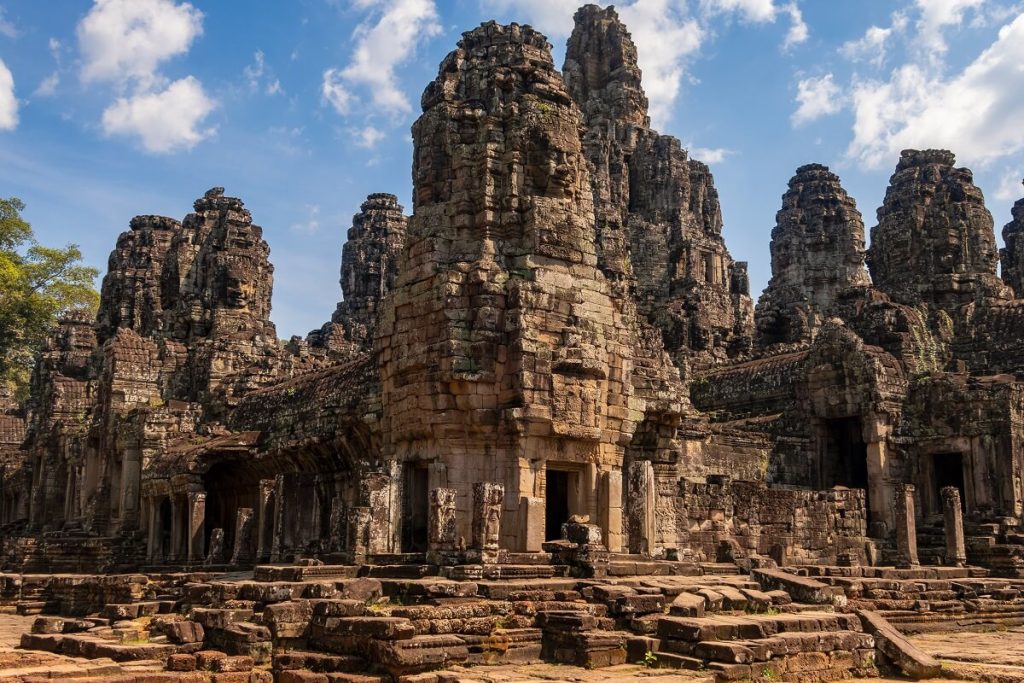
Built between roughly A.D. 1113 and 1150, and encompassing an area of about 400 km², Angkor Wat, is roughly translated to ‘City of Temple’. It is one of the largest religious monuments in the world and represents the architectural pinnacle of the Khmer empire.
Its 65 meters central tower is surrounded by four smaller towers and a series of wall enclosure, recreating the image of Mount Meru -a legendary place in Hindu mythology said to be the home of the god laying just beyond the Himalayas.
Many people refer to the whole Angkor complex as ‘Angkor Wat’, but technically, that only refers to one temple. ‘Angkor’ is loosely translated to Empire, or City, and refers to the entire 400 km² complex, the site of the oldest civilisation in Southeast Asia, the Khmer Empire. It is primarily temples, but the Khmer Empire used to be a city that housed more than 750,000 people.
How to Get to Angkor Wat
The temple was constructed in the city of Angkor, which is now in the country of Cambodia and was formerly the seat of the Khmer Empire. This city contains hundreds of temples and may have a population of over 1 million people. It was easily the largest city in the world at its peak.
The main temples are a close car ride from Siem Reap, which has its own international airport with connections from Southeast Asia’s main hubs. If you are in the Capital of Cambodia, Phnom Penh, the temples of Angkor are a five to six-hour trip by car.
Angkor Wat Religion
Hinduism (Shivaism – Vishnuism) 9th century – 12th century
The early Khmer kings worshipped Shiva, the god of regeneration and destruction. Each temple built was dedicated to a particular Hindu divinity. Later, in the 12th century, Suryavarman II venerated the god Vishnu, a deity often depicted as a protector. To show his devotion, he installed a statue of the god in Angkor Wat’s central tower, and another devotion, a remarkable relief, southeast of the temple. It depicts a chapter in the Hindu story of creation known as the ‘churning of the sea milk’.
Mahayana Buddhism – End of 12th century
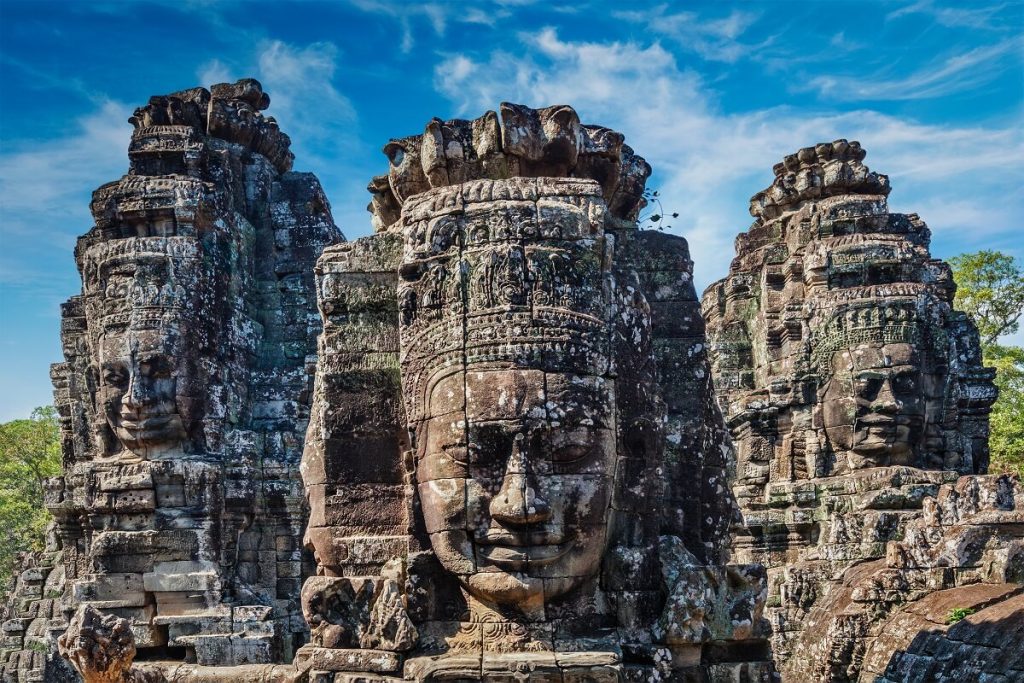
King Jaya-varman VII, a Buddhist of the Mahayana school ascended the throne in 1181 and made radical changes —constructing a new capital city, named Angkor Thom, a Buddhist temple currently known as Bayon, and many monasteries filled with statues of Buddha throughout the Angkor region (instead of Hindu gods). The concept of ‘God King’ was removed, replaced by the Buddhist ‘Englightened Being’, and ‘Lord Who Looks Down’.
Mahayana Buddhism, a later version of Buddha’s teachings was spread throughout Southeast Asia, and the Khmer Empire, placing a greater importance on the Bodhisattvas. Quasi-divine beings who would delay their nirvana to help others attain it. The main Bodhisattva is Avalokitesh-vara or Lokes-vara, was carved at Angkor Thom. The ‘face tower’ was constructed to show the religion’s four sublime states of mind –Compassion, Kindness, Equanimity, and Sympathetic Joy.
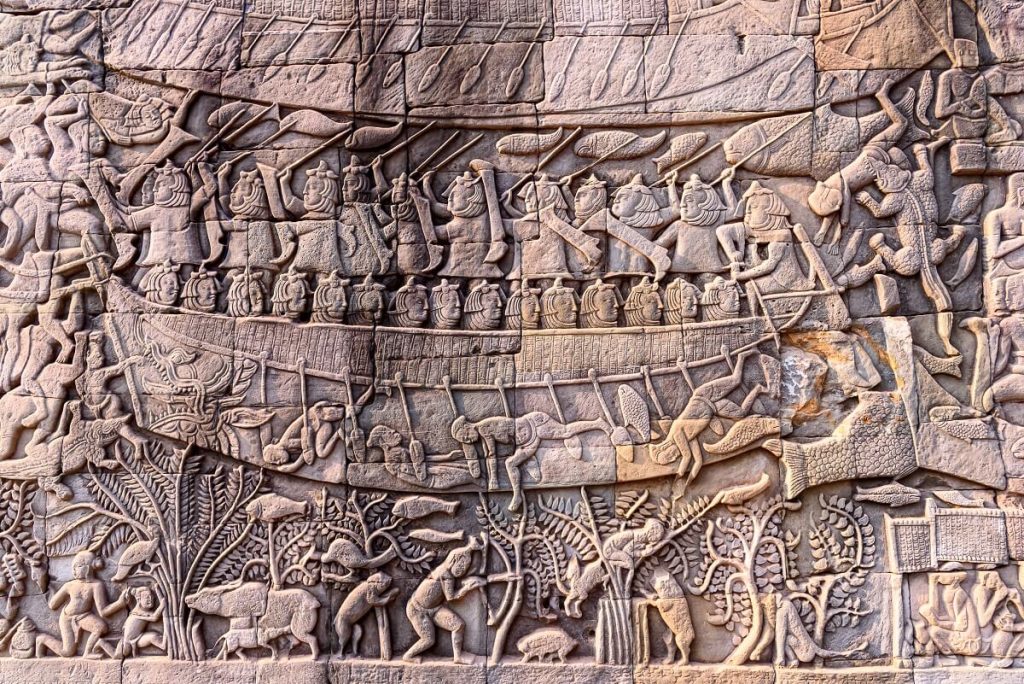
Brief reversal to Hinduism (Shivaism) – Middle 13th century
In 1243, when King Jaya-varman VIII ascended the throne, he proceeded to a systematic defacing of Buddhist sculptures in the temple, crudely altering them into Hindu images. The crude altering is visible at Preah Khan, and Ta Prohm.
Theravada Buddhism – End of 13th century
Theravada Buddhism from Sri Lanka was introduced in 1295 by King Sindra. It became more prominent in the royal court, and the local people, thus becoming the dominant religion in Cambodia today. Unlike Mahayana, the teaching of Theravada Buddhism taught people to seek self their own enlightenment, to abandon worldly desires, and to acquire merits by giving food to monks—making donations to pagodas and worshipping the Buddha. With this teaching, the attitudes of the people towards its Hindu gods and god-king changed, leading to the gradual weakening of the Khmer empire, and it’s eventual collapse in the first half of 15th century. Today, Angkor is a pilgrimage site for many Buddhist Monks. They are often seen in the Angkor complex adorning orange robes while strolling around Angkor amid other tourists.
Neak Ta
Neak Ta is omnipresent guardian spirits of the land and water that populates the supernatural world of the Cambodian countryside. They are not just a kind of simple spirit, but rather a phenomenon or energy force that protects a village community. In Cambodia, they are revered everywhere, along with Buddhism.
Every village, pagoda and house have their own Neak Ta residing in a beautifully decorated little shrine, where people come to make offerings and pray. Neak Ta shrines usually contain small collections of natural or man-made objects such as old stones, wooden carvings, human-like figures and other objects that represent land and spirit elements. Uniquely Cambodian, the energy force or guardian spirit of Neak Ta, unites the community with its earth and water and symbolises the link between the people and the fertility of their land and their ancestors before them. Neak Ta does not fall within the Buddhist precepts. It is believed to belong to an ‘outside realm’, but lives alongside Buddhism in Cambodia –like Buddhism, it does not tolerate unsuitable conduct within the grounds, such as offensive language or act. Neak Ta shrines can often be found in the northeast corner of the grounds of a pagoda.
The Best Time to Visit Angkor Wat Cambodia
Angkor Wat best time to go is between November and March, there’s low rainfall, and reliable sunshine but with those perks come higher prices and heavier crowds. Considered dry season, the ‘greeneries’, are not as lush, and the air can get dusty due to the dry earth. The ‘green season’ or ‘wet season’ (June-October) offers lighter crowds, lower prices and lush photogenic landscapes. Explore early to avoid afternoon showers.
Angkor Wat Sunrise or Sunset Viewing
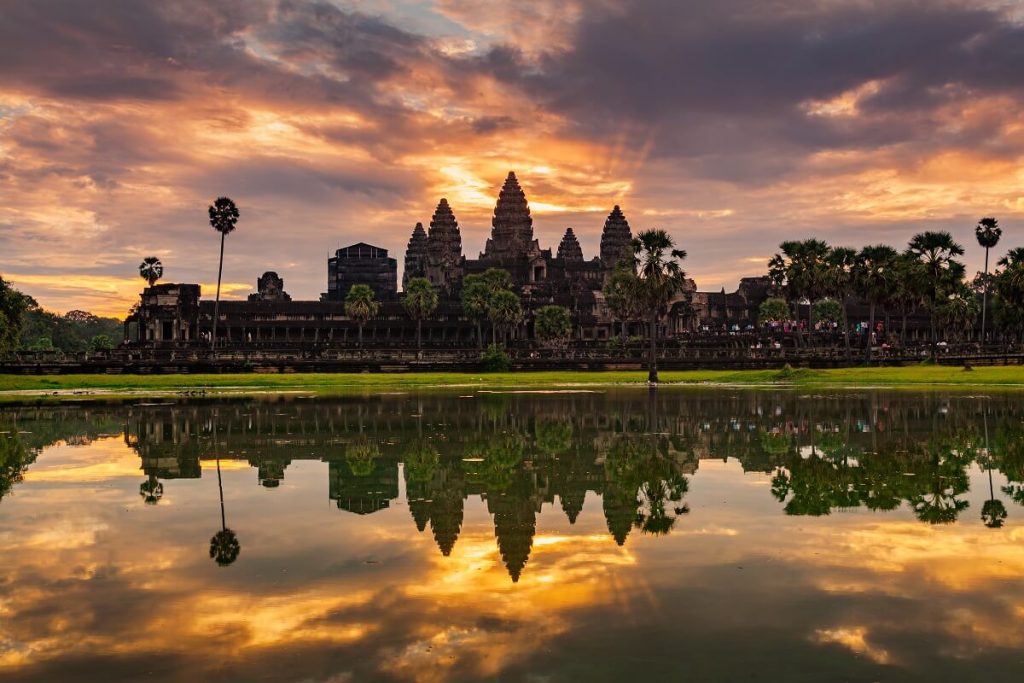
Watching the sunrise at Angkor Wat is the most common choice, and one I highly recommend, but it does require waking up around 4:00 am. If getting up early isn’t your thing, you may go to Phnom Bakheng to see the sunset. However, the latter option is very crowded. But there is some good news recently. The hill at Phnom Bakheng became so popular over the recent year that the management team at Angkor, concerned about damage to the temple there, are restricting the maximum amount of visitors to 300 at a time. It’s an improvement, but still quite a lot of people.
There is an option for tourist to see the sunset at Angkor on a hand-propelled gondola on the moat of Angkor Thom, accompanied with drinks. A great option for those wanting a calming retreat after a long day of temple trekking.
The first time I saw Angkor Wat was during the wet season in July, as the sun was rising on a warm morning. It was absolutely gorgeous, completely surreal, and a bit sad –I didn’t have a camera at the time. Although the experience is worth every effort, I placed to wake up insanely early, there are some other things you need to be aware of.
There’s always a crowd in Angkor Wat, no matter the time of day.
You will feel like guided sheep, from buying your ticket to walking into the temple. Find parking will be a hassle, even for Tuk-Tuk drivers. But as soon as you find a spot, and is able to relax, a street food vendor will inevitably come up to you and tell you to come eat breakfast at their restaurant.
Whether you choose sunrise, sunset, or you’re superman/woman wanting to do both in one day, be sure you give yourself enough time, because there will be lots of people wanting to do the exact same thing.
It’ll all be worth it!
What to Bring to Angkor Wat
Bring a hat. Always. Bring enough water (at least 1.5 litres of water per person), sunscreen, and some light snacks with you. It is insanely hot in Cambodia and if you don’t protect yourself you will burn your skin (I’ve burned my skin, and my skin isn’t fair), or pass out from dehydration. Temple exploration is extremely exhausting, exaggerated by the heat, so it’s wise to take a little break now and then. If you don’t want to carry too much food or water, among the popular temples, there are many little shops that provide food and water –they accept both USD and Riel.
Cambodia has Type A, Type C, and Type G electrical outlets, so bring the right power adapters for all your devices. North American voltage is 110 – 120V. Electrical voltage in Cambodia is 230V and the standard frequency is 50Hz.
Be sure to dress appropriately for the temples by covering your shoulders and knees. Cambodia is still a deeply conservative Country, and especially in Angkor, you need to dress appropriately as it is a Buddhist temple.
Best Way to Visit Angkor Wat
There are many tours you can book ahead online if you take the time to do your research, or read a blog post on recommended tours. However, if you’re an adventurous person who likes to go by the flow of the day, you will still have the chance to book tours on the street of Siem Reap. When you first arrive in Siem Reap, you’ll be bombarded with drivers offering many different types of temple excursions. You can book a tour simply walking around Siem Reap, and accepting one of these drivers’ offer. A few words of advice if you chose this path:
Be patient. Take your time to walk around and compare prices.
Bargain, you’re in Asia. Even though I’m Cambodian, they’ve tried to rip me off a couple of time. I had to walk away for them to shoot me an offer I’ll take.
Rely on your first instinct. Use your gut to determine if the person is trustworthy.
You can also book a tour through your hotel or guest house. In which case, they will often recommend trustworthy tuk-tuk drivers, along with quoting a day cost.
There are multiple ways to travel around Angkor: by tuk-tuk, hired taxi, bicycle and motorbike, many of which you can book by speaking to your guesthouse staff. The two main options that I prefer for getting around Angkor are tuk-tuks and bikes.
I love biking, but don’t forget that this is a HUGE complex, and you will be walking around a lot inside each temple you choose to visit. If you have a whole week excursion, consider biking, but for a 3-day pass or more, I highly recommend a tuk-tuk because of how much energy you’ll be exerting just walking around the temples. If you’re staying at a hotel, they will offer you tours which will cost you a good amount of money, so if you’re like me, and want to spend the money on the local economy, and save at the same time, step out of the hotel and walk the street.
Most tuk-tuk will accept $15-20 per day for your Angkor excursion, and you decide when and where you want to go, for the whole day. I always find one tuk-tuk driver that I trust and build a relationship with him for the whole week that I’m there. He’ll be the only one I hire. I find that this way, they always give great recommendations (mine lowered his daily fee as a bonus). I remember asking my tuk-tuk driver what he recommends, and he said, “Wherever the crowd’s not going.” I agree, whatever temples are popular during that time of the day, just go to the least popular one.
If you choose to bike, there are plenty of options for bike rentals in Siem Reap. If you’re planning to bike, plan your route in advance and be sure to bring a really good map. It’s fun to get lost, but not in a complex this large, on a hot and sunny day!
Romantic Couple Options
There’s an option to get an aerial view of Angkor Wat via helicopter or static hot air balloon. The helicopter rental starts at around $90 USD for an 8 minute flight. I’ve been to Cambodia many times, but never with my boyfriend. When we do have the opportunity to go together, I’m taking this option during the sunset, after a hard day of exploration.
Tip: Save money, don’t book a tour. Avoid the crowds.
With more than a million tourists visiting Angkor Wat each year, it is inevitably crowded, no matter which tour you take. Large or popular tour groups tend to follow similar timetables. In my experience, it is better to avoid tours if you want to avoid crowds. Book a tuk-tuk driver with your guest house, or someone off the street, and set your alarm to wake you before dawn. The Angkor complex is so much more serene when there is fewer visitors and temperature and humidity are at their lowest. Arrive at the temples when doors open at 5:00 am.
After sunrise, most tourists and tour groups head back to their hotels for breakfast (I know, it doesn’t make sense). Don’t follow the crowd, instead, pack up some snacks and water so you can stay out until 9:00 am, when the temples are remarkably peaceful. After a fun, and secluded exploration, return to your hotel for a late breakfast, before heading back to the most popular temples at noon. Angkor Wat or Angkor Thom would be a good option as most tourists are having lunch during that time. The smaller temples are where you should spend your afternoons. At dusk, head to the East Mebon or Pre Rup, to witness the brown stonework turn fiery red at sunset. Or like I’ve mentioned above, do the opposite of the crowds. Your tuk-tuk driver would know where the crowds will be at, at whatever time of the day.
Get a private guide instead
If you don’t know your Khmer Empire history, a well-educated guide could fully explain many things to you. The differences between each temple, their history and significance. Full details about the Khmer civilisation, from its ambitious beginning, its influence in many parts of Southeast Asia, to its inevitable demise. As well as current Cambodian culture, and religion, and how everything is connected. I know while travelling, we’re all on a budget, but it’s well worth it to get a guide. You need to bring context into what you’re seeing, feeling, and experiencing, or throughout the whole trip, you will feel disconnected.
Get creative with photos
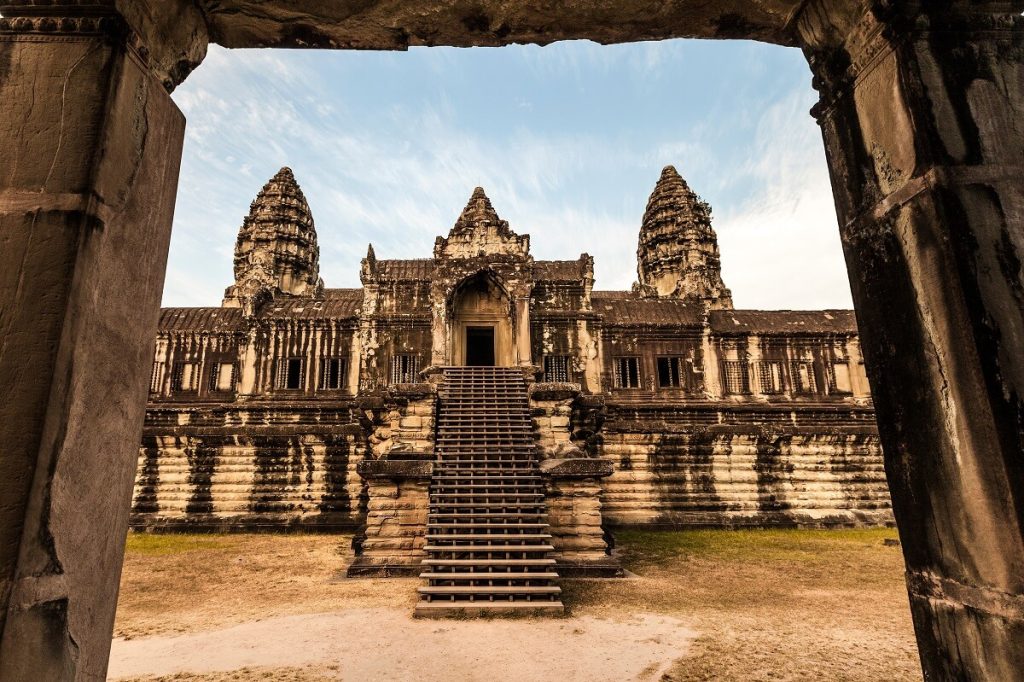
The first time I went to Angkor Wat, many years ago before Angelina Jolie made Ta Prohm popular, I wasn’t overwhelmed by the crowds. There weren’t any. The second time, the whole Angkor Archeological Park was crawling with people, pushing their way through to get the best selfie or the best shot. Needless to say, I moved through the main temples quickly because a) I had already seen them b) I was playing the shoving game (so annoying, I almost started playing the biting game) and c) It’s frustrating trying to get photos of the temple, only to have a crowd of people in said photo.
So my advice is, get creative. Try different angles. If you see the crowd all in one location, go the opposite direction and play with different angles. Mess with editing tools. For example, turn lacklustre photos into black and white classic pieces, and most of all, try to be patient.
Siem Reap Angkor Wat entrance fee
The ticket office is open from 5:00 am to 5:30 pm, but any tickets sold after 5:00 pm are for the following day. Rather than making the ticket office as the first stop at 5:00 am, I recommend you make a separate trip out to the office the evening before your Angkor complex excursions as it gets busy there.
No matter when you head to the ticket office, be sure you bring your passport and cash. Recently, ticket prices have doubled in price as of February of this year, from $22 to $37 for a single day pass. Three-day tickets rose from $40 to $62, and week-long tickets rose from $60 to $72. Price quoted are in US dollars. Sharing a pass or not purchasing a pass is not an option. Your picture will be printed on your ticket, and there are multiple ticket checkpoints.
Get Travel Insurance
Honestly, the first time I went to Cambodia, I didn’t buy travel insurance. I didn’t think I would need it. I wasn’t going to drink regular water, but coconut water instead as suggested by everyone. I wasn’t going to use ice or drink anything with crushed ice in it. My stomach bacteria isn’t as powerful as my cousins who were born and raised in Cambodia, apparently. I basically thought I took all precautions I need to avoid any precarious outcomes. I thought wrong. I don’t know what I ate, or drank, but I came down with a major case of diarrhoea and stomach pain that really affected my travel activities. It was non-stop for 2 days and got me really scared. My mum actually had to take me to the local hospital near Takeo and paid for a checkup.
Long story short, they medicated me and my travel activities were cut short for only 2-3 days. A gecko dropped on me from the ceiling when I was in the hospital bed which made me scream, and got laughs from my cousins. Who thinks geckos dropping on you is the norm, and shouldn’t have solicited such a screaming reaction. Anyways, after that experience, I now understand how important it is to have travel insurance. The truth is that anything can happen. It’s one of those things that you hope you never have to use, but on the off chance that you do require it, it’s a blessing. That peace of mind.
If you’re only doing a layover in South-east Asia, I don’t really recommend getting travel insurance, or if you’re only travelling there for 3 days. But if you’re planning on staying more than a week, I think it is a necessity. It really is up to you, though, so think about that. Do you need that peace of mind? Or will you chance it? In Cambodia, I think it’s a good idea, especially if you’re planning on exploring Angkor. Many of those ancient steps are steep and uneven, and not exactly accident-proof.
Conclusion
Angkor Wat is not only a testament to the Khmer Empire’s creative and architectural triumphs, but also a symbol of Cambodia’s rich spiritual and cultural history. Angkor Wat, however, is more than a tourist attraction; it is a living museum that depicts the birth and collapse of a civilisation, as well as a spiritual site that inspires reverence and astonishment. You will not only be treated to a visual feast if you visit Angkor Wat, but you will also gain a greater understanding of the human spirit and its yearning for beauty, significance and transcendence.
Everything you need to know about Angkor Wat is included in our complete travel guide. We’ve got all the insider secrets to help you plan your trip and make the most of your time at this wonderful place, from its intriguing history and significance to its layout and attractions, to the best times and ways to visit.
Are you ready for an adventure of a lifetime? Look no further than Angkor Wat! With its ancient temples, breathtaking sculptures and carvings, and awe-inspiring sunrises and sunsets, there’s something for everyone to enjoy. Whether you’re a history buff or simply seeking a unique experience, Angkor Wat has it all. Don’t wait any longer, pack your bags and get ready to embark on an unforgettable journey to uncover the wonders of Angkor Wat.

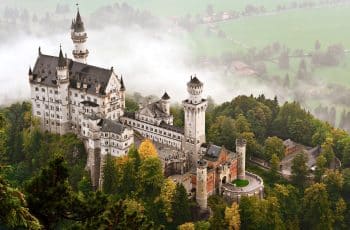
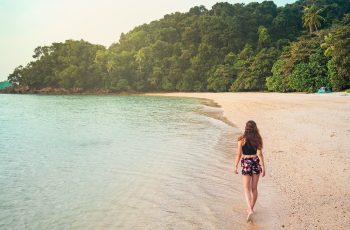

Thailand
Your ultimate travel guide to Angkor Wat is incredibly informative and captivating! The detailed insights into exploring the ancient temples, along with tips on timing and photography, are invaluable for anyone planning a visit. The historical significance and architectural beauty of Angkor Wat truly shine through in your descriptions and photos.
I’m curious, did you have a favorite temple or hidden corner within the complex that left a lasting impression on you? Also, are there any lesser-known tips or experiences you’d recommend for visitors looking to delve deeper into Angkor Wat’s history and culture?
Thank you for sharing such a comprehensive guide to Angkor Wat, and happy exploring!